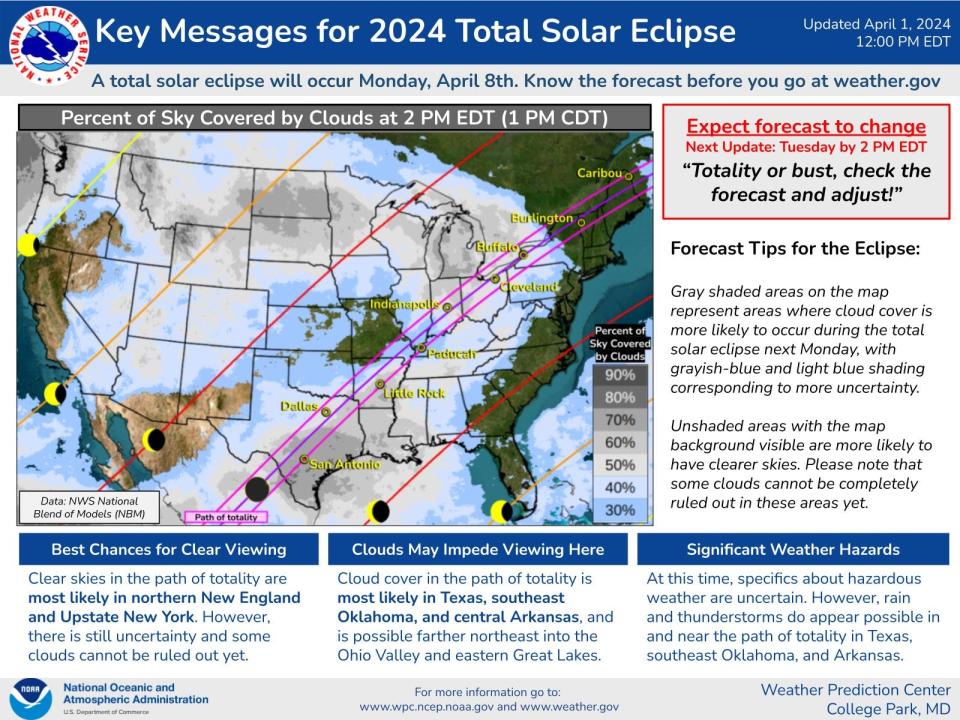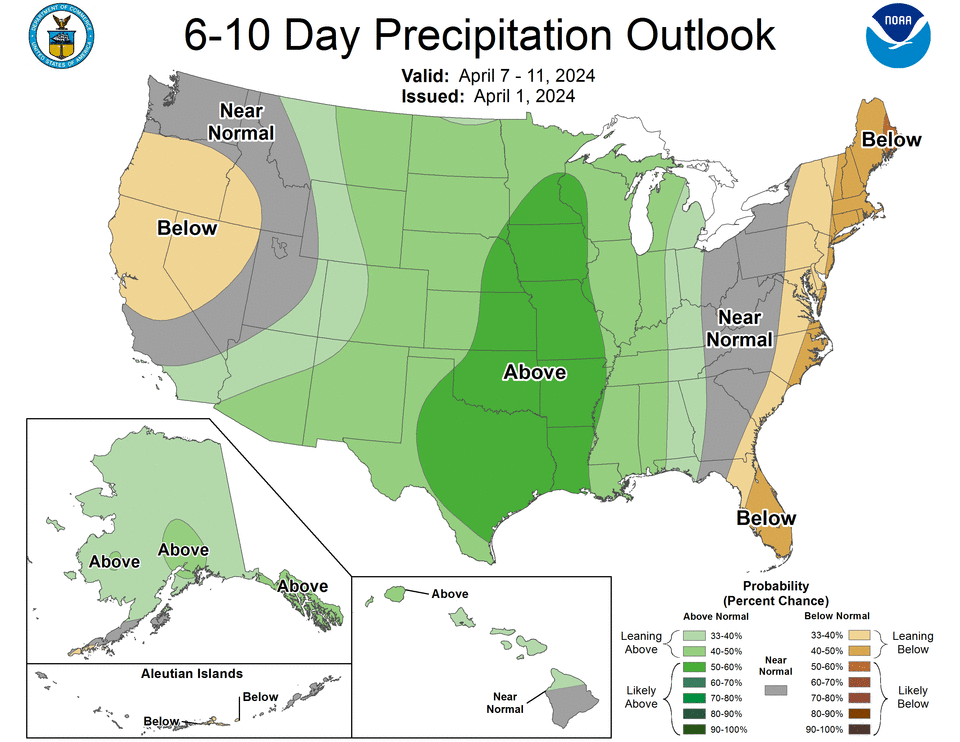What's latest forecast to see eclipse across Florida? Depends on who you ask
Six days and counting.
That's how much longer we have to wait until the 2024 solar eclipse.
While Florida isn't in the path of totality, which means we won't see the moon completely block the sun, we will be able to see a partial eclipse on April 8, but only if the weather cooperates and we have clear skies.
Here's the latest forecast on what to expect, but don't expect a definitive answer yet on whether you'll be able to see the eclipse.
Did you buy a ticket to watch the eclipse from a state in the path of totality?

According to the National Weather Service, which warned via X, formerly known as Twitter, "Totality or bust, check the forecast and adjust," here's what you can expect along the path of totality:
Best chances for clear viewing: Clear skies in the path of totality are most likely in northern New England and upstate New York. However, there is still uncertainty and clouds cannot be ruled out yet.
Clouds may impede viewing: Cloud cover in the path of totality is most likely in Texas, southeast Oklahoma and central Arkansas, which rain and thunderstorms do appear possible. Clouds are also possible into the Ohio Valley and eastern Great Lakes.
What about Florida? Will clouds block our view of the eclipse?
AccuWeather currently is predicting a low chance for clouds across the Panhandle and Big Bend areas of Florida.
Expect cloud cover to increase as you move down the peninsula, with high chances of clouds blocking the view along the East Coast and in South Florida.
"Overall at this time, we're expecting much of Florida will be dry on Monday" because of a system of high pressure off the Carolinas, said Tyler Roys, AccuWeather senior meteorologist. However, increased cloud cover is possible over the state, especially across Central and South Florida, from Jacksonville south to Miami.
"The more northwest you go looks to be the best chance for less restrictions view of the eclipse," Roys said.
The forecast can change, though.
"There could be less clouds along the peninsula of Florida as we get more information on where the high pressure is," Roys said.
A system of high pressure typically brings clearer skies, with flows out of the east bringing ocean influences across Florida. However, it typically bring afternoon clouds and that mix of sun and clouds could be a factor in seeing eclipse.
National Weather Service Florida forecast for April 8 solar eclipse
Here's the extended outlook from the National Weather Service across Florida. While most locations currently are forecast to see mostly sunny skies, it only takes one cloud in the "wrong" place to block our view of the eclipse.
As of now, best chances for the clearest skies look to be in Fort Myers and Sarasota. Remember, forecasts this far out are subject to change.
Pensacola: Partly sunny skies.
Fort Walton Beach: Mostly sunny.
Panama City: Mostly sunny, but 20% chance for showers.
Tallahassee: Mostly sunny.
Jacksonville: Mostly sunny.
Gainesville: Mostly sunny.
Daytona Beach: Mostly sunny.
Melbourne: Mostly sunny.
Orlando: Mostly sunny.
Lakeland: Mostly sunny.
Vero Beach: Mostly sunny.
Fort Pierce: Mostly sunny.
Stuart: Mostly sunny.
West Palm Beach: Mostly sunny.
Miami: Mostly sunny.
Naples: Mostly sunny.
Fort Myers: Sunny.
Sarasota: Sunny.
NOAA's precipitation outlook for Florida

NOAA's 6-10 day precipitation outlook for April 7-11 calls for just about anything, depending on where you are in Florida.
The extreme northwestern tip of Florida's Panhandle has a 40-50 percent chance of precipitation, followed by 33-40% to the east in another portion of the Panhandle.
Most of the state has a 40-50% chance for precipitation over the period.
Countdown clock to 2024 solar eclipse
What time will the solar eclipse be visible in Florida?
While Florida isn't in the path of totality, residents will be able to see a partial eclipse. Here's when you can watch the eclipse from any Florida location.
Click on your location in the map to see:
When the eclipse starts at your location
What the maximum coverage will be
What time maximum coverage will occur
When the eclipse ends at your location
Chances for clear skies based on historical averages for April 8
Roughly speaking, the peak of the eclipse will happen about 1:55 p.m. CDT in Pensacola and 3:02 p.m. EDT on Miami Beach.
Can't see the map? Open in a new browser.
➤ See exact times to go outside to see the eclipse across Florida
Interactive map: Enter your ZIP code to see when the eclipse starts, peak coverage, when it ends
Can't see our graphics? Click here to reload the page.
Enter your ZIP code to see how long the eclipse will last at your location and how much of the sun will be blocked by the moon during the peak. You'll also get the latest weather forecast when it comes to whether there will clear skies on April 8.
The time lapse shows what the eclipse will look from Orlando.
To compare, residents in Pensacola's 32501 ZIP code will see a partial eclipse for 2 hours 37 minutes, with the eclipse starting at 12:35 p.m. CDT and the peak coming at 1:55 p.m.
Residents in West Palm Beach's ZIP code of 33401 will see a partial eclipse for 2 hours 26 minutes, with the eclipse starting at 1:48 p.m. EDT and the peak at 3:03 p.m.
This article originally appeared on Treasure Coast Newspapers: 2024 solar eclipse view: Weather forecast for Florida, best view

